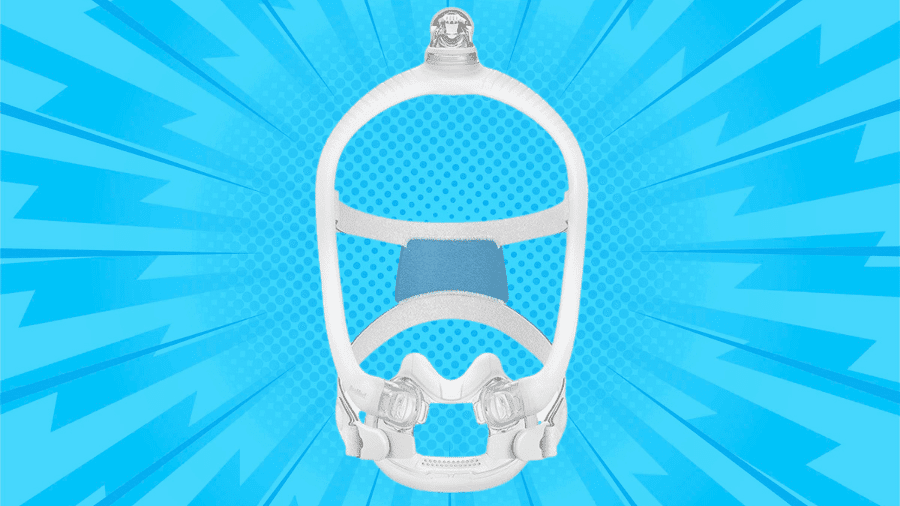The release of the AirFit F30i full-face mask for CPAP from ResMed adds a full-face hybrid mask with a top-of-head tubing connection to the ResMed full-face mask lineup. The AirFit F30i uses an over-the-mouth, under-the-nose cushion instead of a more traditional full-face cushion that covers the entire nose and the mouth.
Hybrid full-face masks have gained considerable traction in recent years for good reasons. They make it easier to get a good seal by reducing the amount of surface area to seal. They avoid the trickier contours of the face where the cheek meets the nose, and they skip the nasal bridge altogether.
Ultra-compact face cushions also meet the full-face CPAP needs of many people while eliminating claustrophobia concerns. Some full-face users need their CPAP equipment for more than just sleep apnea; being able to wear a mask for much of the day while still interacting with others, wearing glasses, or reading and watching TV adds a lot to their quality of life.
Overview of the AirFit F30i
The AirFit F30i face cushion connects to a hollow silicone frame that functions as a conduit for flow from the CPAP machine. The CPAP circuit attaches at the top of the head, and flow travels down the frame to the cushion.
The hollow silicone frame is like the one used in the ResMed P30i and N30i masks. The P30i and N30i masks, though, use different headgear from the F30i and are not compatible with the F30i frame.
The face cushion on the F30i is supported by a headgear with four points of attachment. The top straps seal the cushion under the nose, and the bottom straps hold the cushion below the lower lip. Since the face cushion rests low on the face, and the frame circles the head, most of the face is wide open.
Check Out the Ultra-Compact Cushion
The F30i’s over-the-mouth cushion is carefully curved, particularly around the section that sits under the nose. The F30i cushion does not occlude the nares. The upper edge of the cushion has cutouts for the nostrils, so flow enters both the nose and the mouth.
The curvature on the nasal section gives the cushion an overall shape that is a bit pyramid-like. I found that the curve on the upper edge of the cushion kept any hard, plastic parts of the mask from pressing on my upper lip.
The bottom edge of the F30i cushion should land just above the chin. I tried opening my mouth ridiculously wide and making silly faces to see if I could sneak my lower lip out the bottom edge. With much effort, I could wiggle my lip out, but it seemed to be quite stable when talking and during regular tossing and turning.
The AirFit F30i has a face cushion very similar to the cushion on the AirFit F30. The AirFit F30 has a five-point headgear and connects to the CPAP circuit at the bottom of the mask. The AirFit F30i comes in a choice of four cushion sizes, while the F30 comes in a choice of two cushion sizes.
Quality of Life: Comfort and Ease of Use
The AirFit F30i goes on gracefully. I was able to leave my glasses on while putting them on and taking them off. The headgear attaches magnets to the cushion, and the magnetic attraction is substantial. I did not have to find the clip blindly; the magnets drew themselves together from a decent distance apart.
The headgear is sturdy yet soft, and I suspect it will stand up to regular washing. The velcro attachments are a bit weak and feel like they might lose their stickiness more quickly than I’d like, however. Of course, once you find the right connection spot, you really should not have to undo these with each use.
The frame crosses the crown of the head. When the frame is appropriately sized and positioned, the elbow connector should rest in the center of the head.
The silicone widens across the head and is ribbed to help it stretch or shrink to different head sizes. The frame feels snug but not uncomfortable across my head. It feels like a ball cap tightened up a bit so that it will stay put on a windy day.
ResMed recommends daily cleaning of the face cushion but only weekly cleaning for the rest of the parts. This makes for a fast and simple daily routine to optimize the mask’s longevity.
Head to Head: AirFit F30i and the DreamWear Full Face Masks
The DreamWear Full Face mask and the AirFit F30i are both great designs and a perfect place for someone new to full-face CPAP to start. Both the DreamWear Full Face mask and the AirFit F30i are minimal-contact full-face masks with over-the-mouth, under-the-nose cushions. Both use a hollow silicone frame to conduct flow to the facial cushion from the CPAP circuit connected to the top of the head.
The DreamWear comes with cheek sleeves to put on the frame; the AirFit F30i does not (though oddly its nasal mask siblings, the N30i and P30i, do come with fabric sleeves). Both masks use headgear with four points of attachment and magnetic connections to the facial cushion.
The most common complaint people have with the ResMed and the Philips Respironics masks that use tubular silicone frames is regarding the white noise from the flow running down from the top of the head.
The sound does not bother me; I find it relatively muted and a bit soothing. If you tried the DreamWear masks or the AirFit N30i or P30i and found that to be a concern for you, the F30i is not the mask for you. Give the AirFit F30 a try instead.
The hybrid face cushion on the DreamWear Full face mask has an oblong shape. The cushion on the F30i is vaguely triangular, like a wide-based pyramid with its tip cut off.
The headgear feels a bit more durable on the DreamWear. I have to tug hard to get the Velcro attachments to peel back; those connections are going to hold up over time. The Velcro on the ResMed F30i is less resistant and less sticky.
ResMed claims that in their study of 48 patients, 3 out of 4 preferred the ResMed F30i to the DreamWear Full Face mask. It’s an easy choice for me — the F30i. The DreamWear cushion does not sit right on me.
A hard piece of plastic in the corner of the cushion presses against the bone on my upper lip, and it requires much headgear tightening to hold my lower lip inside the cushion when I yawn.
I tried several different cushion sizes, but honestly, for my facial shape, the DreamWear Full face mask is not a great choice. I don’t think I could sleep all night with it. I wanted it off in 10 minutes. The pyramid-shaped ResMed F30i cushion fit just under my nose better than the oblong DreamWear cushion.
Just like every brand of jeans is not the right brand for everyone, CPAP selection is really individualized. No product is “the best” for 100% of people. 25% of people in the ResMed study still selected the Philips Respironics DreamWear, and that absolutely makes sense.
Probably many of the study participants would have been happy with either. Like I said earlier, they are both great designs worth looking at by anyone shopping for a mask that offers full face therapy with minimal contact in the center of the face.
Bottom line
The AirFit F30i is a well-designed mask that has numerous features to satisfy full-face mask CPAP wearers who want much freedom of movement. It’s a stable, high-performing mask that is as unobtrusive as a full-face mask can be.
With four sizes of face cushions and three sizes of frames to choose from, an optimal fit is likely there to be found. The carefully crafted angles of the facial cushion set it apart from its DreamWear rival.
The F30i is worth considering by anyone who wears full face masks all the time. Since it is so easy to get used to, it would also be a good option for nasal mask wearers to have around to use when they have a stuffy nose or if they need to give the bridge of the nose a break from time to time.






